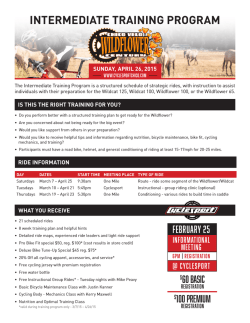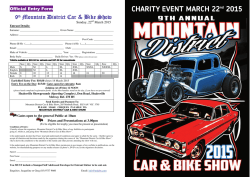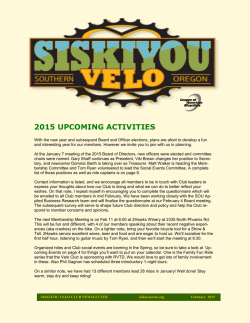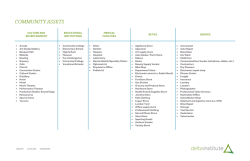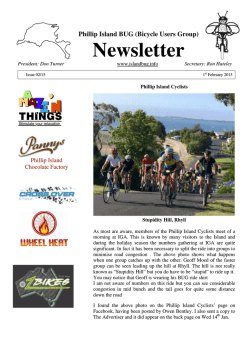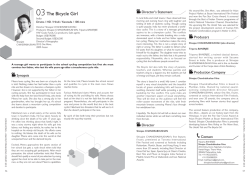
Guía urbana Ciclismo Supervivencia
More praise for THE URBAN CYCLING SURVIVAL GUIDE “With commuting costs climbing and environmental damage from car emissions increasing, cycling is becoming a more attractive form of urban transportation every day. In her charming book, renowned cycling advocate Yvonne Bambrick provides accessible and inspiring information on how we can get out of our cars and onto our bikes safely, thereby improving not only our communities but our own lives too.” — Dr. Faisal Moola, Ph.D., David Suzuki Foundation “Yvonne Bambrick’s highly readable, informative, and compact survival guide speaks effectively to the challenges for cyclists (and drivers and pedestrians) as we get used to sharing the right-of-way.” — Ken Greenberg, urban designer and author of Walking Home “Yvonne Bambrick has written a book that will be loved — and well used — by cyclists of all ages. Her perspective gained as a result of her years as a cycling advocate offers rich context for this terrific book. The Urban Cycling Survival Guide will help cyclists not just survive, but thrive!” — Eleanor McMahon, member of provincial parliament (Burlington), former CEO and founder of Share the Road Cycling Coalition “This book is like the act of riding a bike itself: easy, efficient, and fun. Essential reading for anyone contemplating cycling in a city — and for anyone already doing it.” — David Miller, Toronto mayor 2003–2010 and avid environmentalist “The Urban Cycling Survival Guide is a comprehensive yet easy-to-read book that will enlighten you about all things urban cycling. Yvonne Bambrick is the perfect guide for any beginner cyclist.” — Mia Kohout, CEO and editor-in-chief of Momentum Mag “Packed with useful tips and tricks, particularly for those new to urban cycling.” — Mia Birk, author of Joyride: Pedaling Toward a Healthier Planet “From wearing a skirt or dress shoes to picking a bike to riding safely in traffic, The Urban Cycling Survival Guide breaks the basics of cycling down into manageable and understandable chunks helpful to novices and experienced cyclists. This is cycling for the every-person.” — Gabe Klein, former commissioner of Chicago and Washington, D.C., Department of Transportation and member of the NACTO Strategic Advisory Board Copyright © Yvonne Bambrick, 2015 Published by ECW Press 2120 Queen Street East, Suite 200, Toronto, Ontario, Canada M4E 1E2 416-694-3348 / [email protected] All rights reserved. No part of this publication may be reproduced, stored in a retrieval system, or transmitted in any form by any process — electronic, mechanical, photocopying, recording, or otherwise — without the prior written permission of the copyright owners and ECW Press. The scanning, uploading, and distribution of this book via the internet or via any other means without the permission of the publisher is illegal and punishable by law. Please purchase only authorized electronic editions, and do not participate in or encourage electronic piracy of copyrighted materials. Your support of the author’s rights is appreciated. Library and Archives Canada Cataloguing in Publication Bambrick, Yvonne, author The urban cycling survival guide : need-to-know skills and strategies for biking in the city / Yvonne Bambrick; illustrations by Marc Ngui. Issued in print and electronic formats. ISBN 978-1-77041-218-7 (pbk)—ISBN 978-1-77090-709-6 (PDF)—ISBN 978-1-77090-710-2 (ePub) 1. Cycling—Handbooks, manuals, etc. 2. City traffic—Handbooks, manuals, etc. I. Ngui, Marc, 1972–, illustrator II. Title. GV1043.7.B34 2015 796.609173’2 C2014-907623-1 C2014-907624-X Editor for the press: Jennifer Knoch Cover illustration and design: Marc Ngui Interior photographs: Yvonne Bambrick Author photo: © Javier Lovera We acknowledge the financial support of the Government of Canada through the Canada Book Fund for our publishing activities, and the contribution of the Government of Ontario through the Ontario Book Publishing Tax Credit and the Ontario Media Development Corporation. To my father, Timothy, for taking me along on the ride, and my mother, Barbara, for nurturing my independent spirit. ix 1 39 112 129 150 174 187 194 Bikes. Are. Everywhere. It doesn’t take a study or statistic to prove that bicycle ridership is way up across North America — the sheer number of bicycles on the streets of your city, and even in upscale clothing store windows, is proof enough that the bike boom is upon us. Not since the 1890s have bikes been this cool. The timeless bicycle, once known as the mechanical or iron horse, is one of humanity’s oldest manufactured self-propelled personal transportation vehicles, and one that’s had a profound impact on our history. From its vital role in the emancipation of women and dramatic changes to their acceptable everyday clothing (hello, bloomers!) to the paving of our city streets, the first flight, and the widely accessible transportation of people and goods over ever-greater distances, the ix x THE URBAN CYCLING SURVIVAL GUIDE bicycle is nothing short of a two-wheeled wonder. Its classic design hasn’t even changed much since 1885, when the safety bicycle, with two same-sized wheels, a drive chain, and inflated tires, was invented. While most of our North American cities are in varying stages of adaptation to the bicycle (and yes, we’re far from the bicycle nirvana of many European cities), millions of North Americans are choosing a bicycle for daily transportation. Gone are the days when bikes were seen as the last-resort transport of the poor or the domain of men in tight shorts and brightly coloured jerseys, a.k.a. MAMILs (middle-aged men in Lycra). Far more women and men of all ages, backgrounds, and occupations are now riding — and they’re wearing whatever they like to do so. Bicycles are increasingly being seen, understood, and praised as the gloriously efficient, fun, fast, elegant, and accessible vehicles that they are — a classic solution to so many of the issues that seem to plague our cities. “When you ride your bike, it isn’t just transportation, it is the key to designing the sustainable cities of the future,” says Lloyd Alter, managing editor of TreeHugger.com. With this growth in ridership, city governments across North America are also increasingly investing in expanded and updated bike infrastructure and programs, and they are recognizing bicycles as an important form of sustainable urban transportation that can INTRODUCTION help ease the burden of traffic congestion. While we might be on our way, we’re not there yet: Interestingly, the most bike-friendly large city in North America, Portland, has the same bicycle ridership (6 per cent), as the least bike-friendly city in Germany, Stuttgart. But as John Pucher and Ralph Buehler point out in their book City Cycling, with the right policies in place, levels of cycling can be dramatically increased: “Cities of all sizes with very different land use patterns, histories, and cultures have succeeded in increasing cycling and making it safer.” Unlike that found in the more-established cycling cities, North American transportation cycling culture is still growing and maturing; every year we have more riders with varying levels of skill. With a relatively young bike culture, limited bike-specific infrastructure (bike lanes, etc.), a gap in bike education, and a wider variety of riding conditions to adapt to, some cycling norms are still in development. New riders pick up cycling habits from watching others and through their own experiences. Although honing skills through observation and experience is important, it’s crucial to start from a solid foundation of knowledge. And that’s where this book comes in. As a fulltime cycling advocate, I noticed adults getting back on their bikes with only a partial understanding of how to be part of traffic on two wheels instead of four, or xi xii THE URBAN CYCLING SURVIVAL GUIDE no understanding at all if they’d never gotten a driver’s licence. The physical act of riding a bicycle — the balance and muscle movements needed to propel the vehicle forward — does come back quite easily. The part where you ride that bike out into the often fastpaced and shared vehicular roadways of your city is not quite so simple. Although my first taste of independence was on my bicycle, like many, I felt the next level of freedom behind the wheel of the family car. I’ve been a licenced driver for over 20 years, and I actually quite like driving and can appreciate motor vehicles as the tools they are. I’m certain that being a cyclist first made me a better driver, and that being an occasional driver makes me a better cyclist, because it allows me to understand the roadway from both perspectives. I sold my Toyota Corolla in 2000 and used the money to pay for part of my post-graduate studies. Though I hadn’t ridden much since my commute to and from high school, it didn’t take me long to get back into the rhythm of the ride and realize what I’d been missing. The idea of buying a car hasn’t crossed my mind since, and I’ve built my life in such a way that it shouldn’t ever have to. Getting back in the saddle allowed me to step back and see driving and car ownership from a whole new perspective. I realized that owning and habitually overusing a car for short trips actually made me and INTRODUCTION billions of others far more dependent on all the systems required to make, buy, park, insure, repair, and fuel a car, rather than providing the independence I’d originally connected to car ownership. Cars, while useful and essential to some, are also a factor in so many of our societal ills — obesity, stress, diseases related to a sedentary lifestyle, worsening air quality, urban sprawl, and divided communities to name but a few. Cars might be symbols of independence and freedom in advertising and rock anthems, but I’ve come to fully appreciate that bicycles actually provide it, and so much more. I haven’t written this book to convince you to become a full-time cyclist or give up driving. You are the only person who can make decisions about your daily transportation choices. My goal is to give you the information you need to be a confident rider whenever you choose: on weekends, once or twice a week, rain or shine — totally up to you. But in case your conviction is wobbling like your bike on the first ride back, here are a few reminders of why it’s worth braving those often daunting city streets on two wheels. Convenience If you’re used to a car, that might feel like the most convenient way to get around — you get in, turn on some tunes, and off you go. But how convenient xiii xiv THE URBAN CYCLING SURVIVAL GUIDE is it to waste time in traffic or looking for parking? A short trip by bike is almost always faster than one by car in an urban context, especially during rush hour. When you’re in a hurry to get somewhere, there’s nothing quite as satisfying, or motivating frankly, than effortlessly whipping past a long line of cars stuck in traffic. By the time they get through that last light, you’ve made it three blocks closer to your destination. Any busy person who is pressed for time can immediately see and feel the benefits of using a bicycle for getting around the city. Reduced and predictable travel time alone makes the bicycle a worthwhile, and minimal, investment. And if you can fit in a bit of easy cardio on your way to and from work, school, or errands, you’ve basically bought yourself more time for something else. Autonomy Bikes are empowering, allowing you to get where you want to go on your own terms. You set your own pace and schedule, choose the door-to-door route you prefer, and kiss the malicious whims of transit delays and traffic jams goodbye. Also, don’t underestimate the sense of accomplishment that comes from getting places on your own. Theatre-maker and songwriter Evalyn Parry says, “One of my cycling heroines is Frances Willard, the late 19th century women’s suffrage leader of Evanston, Illinois, who put it so well INTRODUCTION in her 1895 book about cycling: ‘She who succeeds in gaining mastery of the bicycle gains mastery of life.’ Riding is so much about the pleasure of powering my own journey, moving at my own pace under my own steam.” A Healthier Body and Mind Cycling is a low-impact activity and is thus accessible to many people. Sure, you can put on sports clothes and go for a hard, fast ride to really get your heart pumping, but more often than not, riding a bike is a pretty easy form of exercise that you don’t really notice you’re doing — until you get to a hill, of course. According to an Organisation for Economic Cooperation and Development (OECD) study on cycling health and safety, “Cycling significantly improves health and, as a form of moderate exercise, can greatly reduce clinical health risks linked to cardiovascular disease, Type2 diabetes, certain forms of cancer, osteoporosis, and depression. . . . Not only does cycling reduce diseaserelated deaths, but it also contributes to substantially better health.” And if you’re afraid the risks of urban cycling overshadow the benefits, the same study can help you rest easy: “On balance, the positive health impacts of cycling far outweigh the negative health impacts . . . including crash-related injuries and air pollution.” xv xvi THE URBAN CYCLING SURVIVAL GUIDE But it’s not just about a healthy heart or legs of steel, says the OECD: “As well as improving physical health, cycling has a positive effect on emotional health — improving levels of well-being, self-confidence, and tolerance to stress while reducing tiredness, difficulties with sleep, and a range of medical symptoms.” Or take it from Momentum Mag’s CEO and editor-in-chief, Mia Kohout: “Riding a bike is my time of greatest reflection, creativity, and revelation. It is also a time when I get to slow down, breathe fresh air, and take in the sights, sounds, and smells of my city. Sometimes I don’t feel like riding, so I don’t, but I have never regretted it when I do.” We spend so much of our busy day sitting idly that it makes sense to mix exercise with something practical rather than trying to find time to get to the gym. As my good friend, local restaurant owner, and long-time cycling advocate Shamez Amlani is fond of saying, “Why drive to the gym, when you can ride to the restaurant?” Money in Your Pocket Other than the initial investment in a bicycle and necessary accessories, usually somewhere between $200 and $2,500 depending on your means and needs, riding a bike for transportation is the cheapest way to go besides walking. A bike costs nearly nothing to ride, park, or fuel. You can do most basic maintenance yourself, and parts and repairs are INTRODUCTION quite inexpensive. Say goodbye to your gym membership and slash your spending on public transit and taxis or gas, parking, and car repairs. If you go completely car free, an increasingly popular choice in dense urban centres, you’re also off the hook for monthly car payments, maintenance, and insurance. According to the U.S. Bureau of Transportation Statistics, the annual operating cost of a bike is from $308 to $821 (if you include added food [i.e., fuel] costs due to increased exercise) compared to the $8,220 to $11,000 it takes to run a car. Practical, Efficient Mobility The majority of trips we take and errands we run in a day are under 5 kilometres (3 miles) from our home and perfectly suited to travel by bike. In addition to its hyper-efficiency at converting human energy into mobility, one of the greatest efficiencies of the bicycle is that it manages to fit into and make use of tight spaces. Bikes can go places cars can’t — they are nimble, versatile, fast, slow, sturdy, and light. They’re also just plain practical and can allow you to experience your urban environment in a whole new way. (Re)Discovering Your City Whether you’re new to your city or have lived there your whole life, it can surprise you when you see and feel it from two wheels. xvii xviii THE URBAN CYCLING SURVIVAL GUIDE Consultant Ken Greenberg writes, “For me, especially from the raised vantage point of a bicycle seat, the feeling is reminiscent of snorkelling. Like an exotic seascape seen from a fresh perspective, the city reveals itself in new ways. Self-propelled motion at relatively low speeds offers us more than exercise and a chance to commune with our neighbours. It restores a geographic intuition that was weakened by the car — a feel for the real distances between things, a sense of the connections between the parts of the city. It gives us back the ability to move through barriers between neighbourhoods and city districts, heedless of traffic volume or the many limits restricting where a car can go and when it can go there.” You also might end up spending more time in local businesses. Money spent on cars and fuel is mostly leaving your community, whereas cyclists and pedestrians put more money into local businesses. According to two studies done in Toronto (2009) and Portland (2012), customers arriving on bike or foot visit more often and spend more money cumulatively than car drivers. Eco Warrior Cred We all know that bicycles have way less of an impact on our environment than cars — they cause no noise or air pollution, need no toxic batteries, and require fewer non-renewables to build, run, and INTRODUCTION maintain. Bicycles are far less implicated in the global oil industry and cause fewer resource extraction and waste concerns. This certainly makes me feel better as I make my way around my city, and never more so than on smog days when I know I’m not to blame for the bad air quality. In short, bicycles are the ultimate sustainable transportation vehicles. Fun And if you weren’t already convinced, let me just add that riding a bicycle is exhilarating. Who doesn’t want to have fun on the way to work? Many people call their ride to and from work the best part of their day. Rather than adding to end-of-day fatigue, riding provides an energy boost after a long day. So using a bike for transportation is cheap, efficient, practical, fun, convenient, and even healthy. Despite all those positives, riding in a fast-paced urban environment can still be intimidating. But remember, you don’t need to jump in at full speed. Start on quiet side streets or on bike-specific paths, then work up to bike lanes and faster moving city roadways as your confidence grows. All city streets can become accessible to you by bike once you understand how to safely navigate them. Each chapter addresses various aspects of urban cycling, from picking the right bike for your needs and xix xx THE URBAN CYCLING SURVIVAL GUIDE learning the rules of the road to how to read other road users and navigate common obstacles. This is need-toknow stuff that might otherwise take you a long time to learn, often the hard way, through on-street practice and observation. While some of these details may already seem like common knowledge to you, they may be news to others. My goals are to give you a head start, or in some cases a reboot, in what will remain a daily learning experience and help you to better anticipate and appreciate the ups and downs of life on two wheels. 1 Other than confidence and a good sense of how to behave as part of traffic, the only thing you need to get started cycling is a bicycle. You can begin by borrowing a bike or using a bike-share program if your city has one, but most people will soon want a ride of their own. It can be a bit overwhelming deciding which bicycle to pick, so in this chapter I’ll be your guide to the bike styles and basic equipment you’ll need to get you road-ready. When I started riding regularly again in my early 20s, I went with an inexpensive used bike that a friend offered to me. It needed a repair, so with that (and a new lock) as the only expenses, I was off! I’ve since had about a half-dozen second-hand bikes that served their purpose but were nothing special. Each one was fairly 1 2 THE URBAN CYCLING SURVIVAL GUIDE generic looking and eventually either stolen or ridden beyond repair. In 2008, in part because of my new role as Toronto’s cycling advocacy spokesperson, I got serious about the type of bike I was riding and picked up a life-changing (I’m not kidding) Dutch-style upright city bike. I currently have two bicycles — the Dutch bike, which serves as a workhorse for carrying groceries and any number of things, and a road-style city bike for longer distance or uphill rides when a lighter, faster bike makes it a bit easier going. There are several basic bike styles and many models to choose from, but the easiest way to start is talking with friends who ride and shopping around online. Next, find the nearest bike shops and visit them to see, feel, and try out what they’ve got in stock. Researching through friends and online means that you can be better prepared when you get there and know what you want to try out. Even if your budget only allows you to pick up a bike from a large chain retailer, visiting independent bike shops can give you a better sense of the bike landscape, and they are a good place to ask “bikey” questions. If you continue to ride regularly, chances are you’ll eventually want to upgrade your wheels, and independent bike shops are the place to do so. Bike shops can be fantastic community hubs and a great source of all kinds of bike-related information. It’s not uncommon to build a strong connection to GEARING UP a particular bike shop that you find welcoming. Eric Kamphof of Toronto’s Curbside Cycle says, “My job is to link new city cyclists with that object that makes them a cyclist: their bike. So much has to do with the bike. A city has a certain pace, a beat, and a city bike rides in tune with that beat, keeping you upright, aware, and a beautiful part of the landscape. So much of the success of Paris’s Velib bike share program, or New York’s Citi bike has to do with the bike itself. Take one ride and the world just opens up. You don’t just feel safe, you feel free. That’s what a city bike does, it empowers you, it demythologizes all the fears put upon city cycling and reveals the uncomplicated joyfulness that it is.” You don’t need to be a “cyclist” to ride a bike. The term is just a convenient way to refer to someone using a bicycle. But how do you find a good, honest bike shop? Zack Stender, co-owner of San Francisco’s Huckleberry Bicycles, advises asking around: “A shop with a knowledgeable staff and a strong selection of bikes in the type you are looking for will do wonders for your shopping experience. Also, not all bike shop service departments are equal, so you would be well advised to patronize a shop with a reputable mechanic staff. Online reviews 3 4 THE URBAN CYCLING SURVIVAL GUIDE can be helpful but talking to other folks who ride is best. Ask other cyclists which shops they prefer, and when you visit these locations follow your gut.” Bike shops are primarily in the business of selling and repairing bikes, and they can get ridiculously busy from spring through fall, in particular in cities with harder winters. So with that in mind, unless you have an urgent repair, try to time your visit based on your needs and their schedule. If you’re not sure what seasons or days are more busy or less busy, ask the staff. You can be pretty sure that there will be less people stopping in on a rainy day (unless, of course, you live in a very rainy city), and equally certain that the first nice spring weekend after a cold winter will be a gongshow that is best avoided. Fall is usually a great time of year to buy a bike, as many are on sale near the end of the season — the new year brings the latest models. Shops may have less selection, but they’ll be less busy. Keep an eye open for bicycle trade shows — they’re a great chance to meet the local retailers, ask questions, see what models are going to be available for the new year, and test out different styles of bicycles all in one place. You’ll be able to place an order if you find a bike you like. Before you actually take the plunge and pick up your ride, there are several things to consider. GEARING UP Budget What do you currently spend monthly for transportation? How often do you think you’ll ride your bike instead of taking public transit? If you’re going to be driving less and riding more, how much will you save on gas, parking, tickets, and time if you ride two, three, or five days a week in weather you’re comfortable riding in? Remember, you get what you pay for. A good bike is worth the investment. Assuming you do everything you can to keep your bike safe from theft, you’ll probably have it for several years — let’s say five years for this budgeting exercise. Add up the money you estimate you’ll save every year by riding, multiply it by five, and then divide it in half. That’s more than enough to pay for a great bike that suits your needs. You may not have this money at the ready now, but this exercise is meant to put what seems like an expensive purchase into perspective. Don’t forget to allocate a bit of money for necessary accessories like a lock. (Read more about accessories later in this chapter.) Distance of Travel Something for long weekend rides or just for short daily errands? If you’re commuting, how many kilometres (or miles) will you log daily? Travelling longer distances often means you’ll want a lighter bike, but you’ll also have to factor in terrain and speed: 5 6 THE URBAN CYCLING SURVIVAL GUIDE ◊ What’s the terrain like where you’ll be riding? Paved city streets or the nearby park trail? Mostly flat, hilly, or a bit of both? Are there many potholes in your city or are the roads well maintained? ◊ Are you planning to try to keep up with car traffic, move swiftly but carefully, or take a slow and steady approach? It should be noted that safely keeping up with regular fast-moving car traffic takes time and practice. Doing so with little on-street cycling experience can be bad news. Parking and Storage Where will you be storing and parking your bike, overnight in particular, at home and at your main destinations? Do you have access to a garage at home or secure indoor bike parking at your office? Do you live in an apartment and plan to bring your bike inside? Is there an elevator available and does your building allow bikes inside and on the elevator? Will you be leaving your bike locked up outside? If you need to carry your ride up a flight of stairs, for example, a light bike will be a priority. Trust me when I say that doing this twice daily, or more, in particular if you have a load on your bike, will take a toll on your body. If you are bringing your bike indoors and into an GEARING UP elevator, always remember to be conscientious of others by making space for them and keeping dirty tires away from people’s clothing and from walls. MEET YOUR MATCH: FINDING THE BIKE FOR YOU The bicycles that fill our cities are as diverse and colourful as the people riding them. There are, however, some basic styles to choose from, and this list should help you discover what type of bike might work best for you. Road Bike Designed with speed and longer distance road travel in mind, these bikes usually have a sleek, light frame; smooth, thin tires; and position the rider so that the upper body is out front and down to reduce 7 8 THE URBAN CYCLING SURVIVAL GUIDE wind resistance. This position requires you to hold your head up and back so that you can see properly, and it can be uncomfortable for your neck and lower back. Gearing provides many speed options, allowing you to adjust to terrain and navigate steep inclines. Though road bikes are the best choice for speed, high speeds in a race position can be unsafe in busy mixed traffic. You generally want to have your head up so that you can see everything coming your way. Some people are also less comfortable with the skinny tires. That said, road bikes are a preference for confident riders for whom speed and the ability to easily cover longer distances are of highest importance. City or Upright Bike The European-style (or Dutch-, English-, or Italian-style) city bike is designed as a practical everyday bike for commuting and year-round use. These bikes often have a step-through frame (with a GEARING UP top tube that dips down), which makes getting on and off easier, and a rear rack, skirt guard, chain guard, built-in lights, a rear wheel lock, and a comfortable tall handlebar position. The rider sits in a sturdy upright position, allowing good visibility and sightlines. Some are single speed for extra simplicity on flatter terrain, while others have gears, often internal, which help with small hills. Higher-end city bikes also often have internal hub brakes, which can perform better when the weather is nasty. Mountain Bike With a thicker frame and wheels, knobbly tires, and a more upright riding position, this is a steed made for off-road riding on uneven terrain, whether it’s forest trails or urban roads that ride like rumble strips. This style is less efficient for urban commuting — it may handle rough roads a bit better, but the tires can slow you down on longer commutes. 9 10 THE URBAN CYCLING SURVIVAL GUIDE Hybrid This popular choice for city riding has a thicker, more robust frame and wheels than a road bike, providing riders with a less hunched-over position, though not quite as upright as a city bike. The tires have grip but are faster than those of a mountain bike. Folding Bike These nifty transformers are a fantastic option if you want to easily bring your bike indoors or onto public transit. Some are easier than others to GEARING UP collapse and reset, but smaller wheels don’t have too much impact on speed for regular rides across the city. There are various styles, features, and levels of functionality. Cruiser Primarily used for recreation, these bikes are often more stylish. With extra-thick tires and a wide, relaxed handlebar position, choose this model for relaxed weekend rides rather than daily commutes. Electric Assist Bike (or Pedelec) These bicycles have an integrated battery that provides extra power to the rider when they pedal, and they come in various models and styles. However, many regular bicycles can be fitted with an electric battery boost that can assist the rider in propelling the bicycle. This can be particularly 11 12 THE URBAN CYCLING SURVIVAL GUIDE helpful for older riders, people with mobility issues, those hauling heavy loads, and people who have long commutes. There are also e-bikes that are powered via a throttle on the handlebars and require no pedalling. They are essentially electric scooters/motor vehicles. Not all e-bikes are created equal, and the rules that govern their use vary widely since they are a relatively new (re)addition to the bicycle landscape. Fixed-Gear Bike Not for beginners, “fixies” directly connect the pedal stroke with the rotation of the rear
© Copyright 2025
